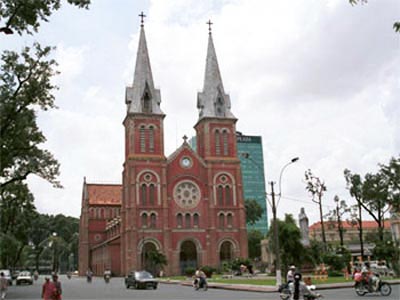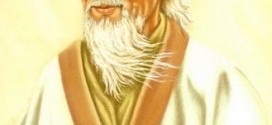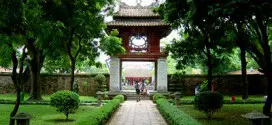Christianity enters Vietnam
Christianity was introduced to Vietnam in the 16th century by missionaries from Europe’s main Catholic evangelist countries, France, Spain, and Portugal. One of the early arrivals was Alexandre de Rhodes, a French Jesuit who greatly impressed the Trinh lords who ruled the north at that time, thus easing the way for permanent missions in Hanoi, Danang and Hoi An.

Expulsion from Vietnam
As the creator of the Romanised written form of the Vietnamese language, Alexandre de Rhodes could justifiably be considered one of the founding fathers of modern Vietnam. However, his reward was expulsion along with all the other Christians when the Trinh lords decided that Christianity in the form of Catholicism was subverting the beliefs that kept them in power. Apart from its later use in the Catholic Church in Vietnam, his script was ignored until the 20th century.
However, de Rhodes continued to proselytize through the Societe des Mission Etrangeres, a French evangelical organization he helped to create, seeking converts throughout Indochina. In the following years, Catholicism was re-established in Vietnam and grew rapidly.
Oppression under Minh Mang
By the beginning of the 19th century, there were many thousands of Catholics in Vietnam. Catholicism’s relationship with Vietnam’s rulers was uneasy: the kings were wary of its doctrine of equality in the eyes of God, a belief that directly challenged the feudal Confucian system that legitimated their control. Under King Ming Manh, a strict Confucian, suspicion turned to oppression. Churches were razed, and Vietnamese and foreign devotees refusing to renounce their faith were executed.
Enter the French
Minh Mang’s excesses, although much exaggerated, gave the French the excuse they were looking for to invade, and Catholicism was reinstated. The Catholic Church flourished under the colonialists’ patronage, opening missions, schools and hospitals all over the country, and becoming Vietnam’s largest landowner. Vietnamese Catholics were favored above their compatriots and became an educated elite.
An exodus to the south
By the 1950s, with the communists governing in the north, over half a million Catholics crossed the demilitarized zone to settle in the south, then controlled by the Saigon regime led by President Ngo Dinh Diem, a Catholic. Those that remained in the north were allowed to continue to practice their faith but under tight control.
The post-war years
After reunification, the communists placed restrictions on the Catholic Church and imprisoned several of its leaders who had actively opposed the new government. Since then, controls have relaxed and relationships between Vietnam and the Vatican have become cordial. However, a papal visit to the second-largest Catholic population in Southeast Asia is still some way off.
The Protestant faith
Protestantism was mainly introduced by the Americans in the south in the form of militant evangelism, and now claims approximately half a million adherents. Many of these are in the ethnic groups of the Central Highlands. In recent years, there has been considerable unrest in the area. American ‘Gospel’ organisations frequently issue ‘reports’ alleging human rights abuse and denial of religious freedom. Putting aside the issue of differing perceptions between the US and Asia about what constitutes ‘human rights’, a trawl of the Internet soon reveals that the aim of many such groups is more political than religious.
The buildings
From a visitor’s point of view, many Catholic churches are well worth a visit. The Gothic edifices of Ho Chi Minh City, Hanoi, Hue and Da Lat are replicas of European cathedrals and are often built of imported materials. They have attractive features, but the home-grown products are of greater interest to the traveler.
The famous ‘Stone Church’
In particular, the ‘Stone Church’ of Phat Diem in the north, the bell tower of which was immortalized by Graham Greene in ‘The Quiet American’, is a highly satisfying blend of Christianity and the Orient. The lifetime achievement of a Vietnamese cleric, Father Tran Luc, it is an architectural gem combining what looks like a Vietnamese temple at first sight with Christian symbolism and statuary. The interior is stunning – a 75m roof supported by huge ironwood pillars and a magnificent altarpiece.
Unusual churches
Many of the churches in the Central Highlands also combine Western and Eastern styles and some have highly unusual features, reflecting the area’s strong animist tradition
 Vietnamese Culture and Tradition
Vietnamese Culture and Tradition 

